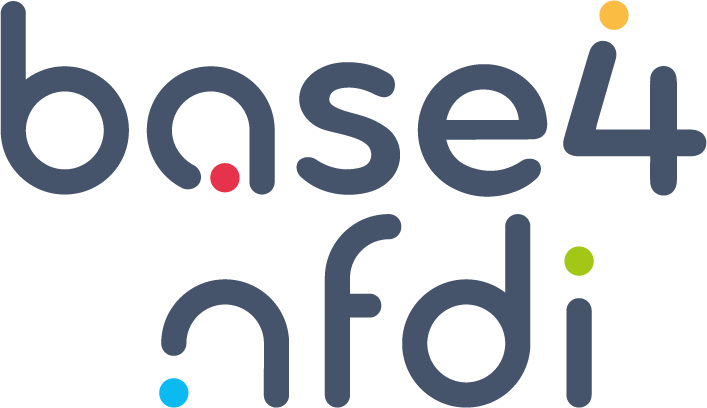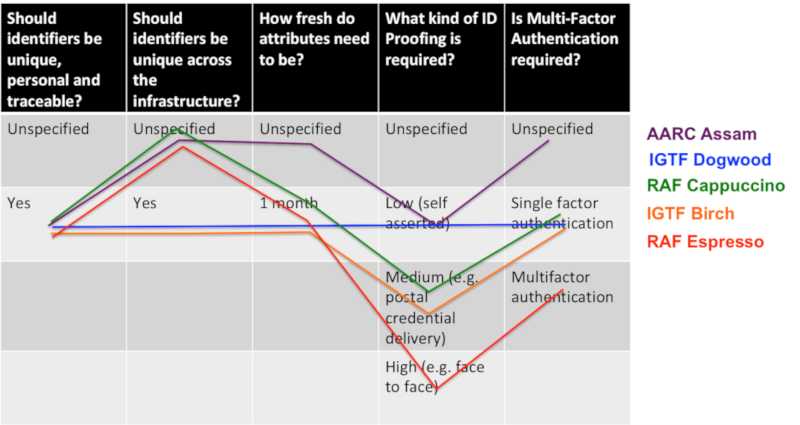
Assurance Details#
As a base for expressing assurance we will rely on the REFEDS Assurance Framework (RAF). Based on RAF, additional assurance profiles are also defined in the AARC-G021 guideline.
There are different assurance levels available within AAI. These
levels are expressed in two different ways, all of
which are transported in the eduperson_assurance claim.
The two different ways are called Profiles and Components.
-
Profiles are composed by a set of components and are believed to make it easier for services to filter the users which they want to let in.
-
Components are available, in case a more complex analysis of the users assurance is required.
Available Assurance Profiles#
We promote the use of these assurance profiles:
AARC Assam: Users that logged in with a “social” identity, such as ORCID, Github, or Google.IGTF Dogwood: Users who belong to a home organisation that fulfils minimal security standards, such as permanently recording which user used which identifier.RAF Cappuccino: Users had to be verified by checking the passport at the home institution.RAF Espressois very difficult to achieve, but may be developed for high-risk services in the future. For the user it means that his/her photo ID was successfully verified against a government database, and he/she uses multi-factor authentication for authentication.
Services should maintain a list of assurance-profiles that they expect their users to comply with.
Available Assurance Components#
RAF (REFEDS Assurance Framework) defines individual components:
Available assurance information are:
-
ID: Identifier uniqueness$PREFIX$/ID/unique$PREFIX$/ID/no-eppn-reassign$PREFIX$/ID/eppn-reassign-1y
-
IAP: Identity proofing$PREFIX$/IAP/low$PREFIX$/IAP/medium$PREFIX$/IAP/high$PREFIX$/IAP/local-enterprise
-
ATP: Attribute quality and freshness$PREFIX$/ATP/ePA-1m$PREFIX$/ATP/ePA-1d

Examples#
-
A user’s assurance from a german university could look similar to this:
"asr": [ "https://refeds.org/assurance/ATP/ePA-1d", "https://refeds.org/assurance/ATP/ePA-1m", "https://refeds.org/assurance/IAP/local-enterprise", "https://refeds.org/assurance/IAP/low", "https://refeds.org/assurance/IAP/medium", "https://refeds.org/assurance/ID/eppn-unique-no-reassign", "https://refeds.org/assurance/ID/unique", "https://refeds.org/assurance/profile/cappuccino" ],In detail:
-
ATP/ePA-1dUser attributes are updated within one day after they changed. ATP/ePA-1mUser attributes are updated within one month after they changed.IAP/local-enterprise: User would qualify for access to the Home Organisation’s internal administrative systemsIAP/low: self-asserted identity together with verified e-mail addressIAP/medium: sent a copy of their government issued photo-ID to the CSP and the CSP has had a remote live video conversation to verify the photo-IDID/eppn-unique-no-reassign:eduPersonPrincipalNamevalue is never reassigned to any other userID/unique: User Identifier:- The user identifier represents a single natural person
- The person to whom the identifier is issued can be contacted
- The user identifier is never re-assigned
-
profile/cappuccino: The profile information that asserts all of the above (see image). -
A user that came via a “social IdP” such as google, github or ORCID would look like this:
"eduperson_assurance": [ "https://refeds.org/assurance/IAP/low", "https://refeds.org/assurance/ID/unique", "https://aarc-project.eu/policy/authn-assurance/assam", ]In detail:
- Missing
ATP/: We cannot make any statement about updates of attributes ID/unique: Social IdPs are generally very good of keeping the identifier linked to the same user.https://aarc-project.eu/policy/authn-assurance/assam: AARC-defined profile to describe social-IdP users.
- Missing
Check your Assurance#
To see your own assurance, go to
https://orpheus.data.kit.edu/, log in and look at the “User Info From Userinfo Endpoint”
Additional Information#
Additional information on the REFEDS Assurance Framework is collected here.
Mapping attributes between SAML and OIDC is discussed in the => REFEDS OIDCre white paper, especially Table 1.
The Proxy and the Assurance#
There are still IdPs that do not support the REFEDS Assurance Framework.
For the time being, we will use the Community AAI to assess the
originating IdP and then assert a given assurance profile (using the
eduperson_assurance claim).
-
Honoring the IdP: essentially, we “honor” the info coming from the IdP, i.e. if the IdP is releasing any of the assurance info, we present it as such to downstream services.
-
IdP “whitelisting”: for IdPs known to follow required procedures for expressing assurance components (e.g. have proper identity vetting), but do not express them via SAML assertions, we can (automatically) assert those claims downstream to SPs that consume this info. This may involve “translating” or “interpreting” certain attributes (e.g. value “staff” may translate to “medium”, while “student” do not, etc.)
-
PI (Principal Investigator) action: the PI is responsible of the VO he/she manages. The PI can accept members that do not meet the assurance requirement, but they cannot access services with assurance requirements that exceed those the users has.
- We are therefore working on a method that allows authorised personnel to raise individual components of a users’ assurance.
- Please understand that this is quite complex and hence still under investigation.